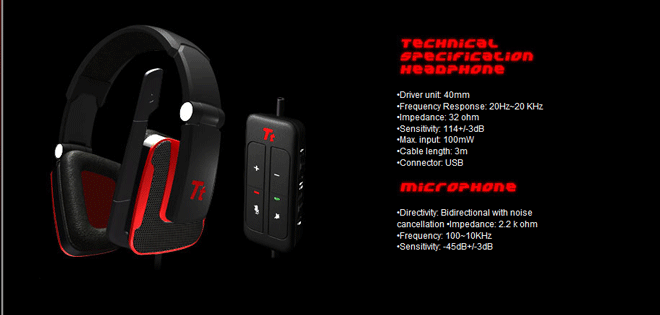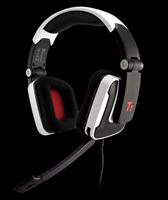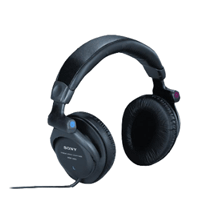Thermaltake Shock One headset is designed to provide the ultimate comfort during gaming while extending the auditory experience to a whole new level. How does it stack up next to its predecessor? Keep reading to find out
Introduction
A few weeks ago, we reviewed the Tt eSports Shock headset. Oriented for gamers, the Shock did not disappoint and provided an extremely comfortable auditory experience throughout gameplay. Today we will be taking a look at yet another product from the Tt eSports series: the Shock One. Let’s see whether this upgraded version of Shock is truly worth the price. Overall, Shock One fits the higher end mark, and up until recently, was considered the most advanced headset in the series. After the release of the Shock Spin HD with 7.1 HD, Shock One is now the second most expensive headset in the series that is fully capable to supporting the Dolby Surround standard.

Thermaltake Shock One is made out of the high quality components and loaded with features to provide the consumer with greater level of comfort and compatibility. Due to the surround sound capability the headset is conveniently redesigned to have a USB 2.0 rather than usual 3.5mm audio input and output. The basic layout of the headset has retained the features introduced in Shock headset:comfortable velvet cushions, 10 level size adjustment frame, and portable low noise cancelling microphone attachment. Aside from the basic features however, the user is provided with a more sophisticated control box as well as personal Thermaltake software that allows for not only control of surround sound options but also customization of frequency production through an equalizer, as well as additional sound effects. With all of these features, the Shock One retails as low as USD95.26 on Newegg.com, in comparison to the simpler Shock, which costs only USD45.92. Are these features truly worth such a huge price difference? Let’s find out.
Features

DTS certification– Premium 5.1CH virtual surround sound gaming headset
Dynamic 40mm– Speaker Driver- 40 mm Speaker Driver with enchanced bass performance
User interface– GUI-Unique graphics user’s interface to customize in accordance to different game categories

NC microphone– high quality noise cancelling microphone for receiving the best communication in gaming activities.
Control box– In-line control box for instant gaming sound control, lighting, and microphone.
10 levels adjustment– 10 levels of headband adjustment to perfectly fit to all head size.
Two ear-pad cushions, including protein leather cushion– adjustment option in order to provide gamers with more comfort.

Gold-plated USB connector– braided cable with gold-plated USB connectors, smooth the signal and data transmission.
Specifications

Pictures & Impressions
The packaging of Thermaltake Shock One is slick and professional, clearly oriented to appease consumers. The contrast of black and red is yet again shown on the packaging and serves as the color scheme of the Tt eSports brand. The front cover has both see-through plastic as well as cardboard, which is rather nice since the customer is able to get a little sneak peak at what they are buying, while still being able to observe all of the basic features of the product. The back explains the features of this product in greater detail and provides the basic outline for the software that is attached with the headset.
Unpacking the Thermaltake Shock One is rather tricky, due to the fact that there a lot of components. Unlike the Thermaltake Shock, this product has also an additional software CD-ROM, as well the as option for the velvet earpads. The actual headset is originally equipped with leather earpads, which provide a great sound and sound isolation however, may not seem as comfortable as velvet. Aside from these new additions the Thermaltake Shock One (just like the Thermaltake Shock) comes with the velvet pouch for the headset, which can be conveniently folded, as well as the brief instruction manual and warranty.
The design of this headset is practically identical to that of its predecessor. The Shock One is designed to be flexible enough to fold for easy transportation, as well as provide a sufficient level of adjustment in order to provide the player with comfort throughout the gaming experience. On each side the Thermaltake One has the 10 level adjustments in order to expand dependent upon the user’s need, while the top has a leather cushion in order to make the sit more comfortably on the head.
The Thermaltake Shock One is also equipped with a low noise microphone which can be easily move in and out of the way as well as a more sophisticated controller in comparison to the original Thermaltake Shock. Aside from the volume control and the mute function on both headphone and microphone, the user is able to lock the controller and also enable or disable the fancy red LEDs on the actual headset. The LEDs are positioned inside the red Tt emblem on both sides of the sets. Another nice feature is the ease with which users can remove the padding–users need only pull on the padding just a little. Beneath the padding the consumer will find 40 mm Neodymium drivers optimized to run in 5.1 configuration.
Testing & Methodology
While there are no benchmarks that are specifically designed to test headsets, nor it is possible to observe performance by either recording the sounds or looping the sound back into a benchmark program, the testing performed on this headset has been done using a recording program, while running 13 tracks at different frequencies in order to assess the sound production capabilities. Additional factors like comfort, sound isolation, and fullness of sound were taken into consideration, along with the basic response to varying frequencies and the change in performance as the result of equalization. We also tested in order to see just how well this headset holds up in the gaming settings. Noise escape, or the amount of sound that escapes the headphone has also been determined in order to see how much of the sound is actually able to reach those around you.
|
Test Rig |
|
| Case | In-Win Dragon Rider |
| CPU |
Intel Core i7 930 @ 3.8GHz |
| Motherboard |
GIGABYTE G1. Sniper |
| RAM |
Kingston HyperX T1 Black Edition 12 GB DDR3 @1600 Mhz |
| CPU Cooler | Thermalright True Black 120 with 2x Noctua NF-P12 Fans |
| Drives |
3x Seagate Barracuda 1TB 7200.12 Drives RAID 5 |
| Optical | ASUS DVD-Burner |
| GPU |
GIGABYTE Radeon HD 6990 |
| Fan Controller | NZXT Sentry LXE |
| Case Fans |
3x Noctua NF-P12 Fans – Side 3x In-Win 120mm Fans – Front, Back, Top |
| PSU |
SeaSonic X750 Gold 750W |
| Mouse | Cyborg RAT 7 |
| Keyboard | Thermaltake Meka G1 |
| Headset |
Thermaltake Shock Thermaltake Isurus Thermaltake Shock One Thermaltake Spin Sony MDRV600 Sony 7509HD |
Results
The Thermaltake Shock One was compared to the Sony MDRV600 headset and Thermaltake Shock. The primary reason for comparison of the Thermaltake sets to the studio headset was the outstanding and proven performance of Sony studio headsets over past several years. In terms of the driver size, the MDRV600 features 40mm drivers just like the Thermaltake Shock and Thermaltake Shock One. However, Thermaltake Shock One has one major advantage, which is the fact that the headset is capable of the Dolby 5.1 surround standard, while the Sony MDRV600 and Thermaltake Shock are not. Due to this feature there seems a rather large difference in price, leading us to ask whether the 5.1 system is truly worth it. Hopefully this question will be answered in our results.
Thermaltake Shock

| Interface | 3.5mm |
|---|---|
| Driver unit | 40mm |
| Frequency Response | 20 Hz-20kHz |
| Impendance | 32 ohm |
| Sensitivity | 114+/- 4 dB |
| Max. Input | 100mW |
Sony MDRV600

| Interface | 3.5mm |
|---|---|
| Driver unit | Neodymium |
| Frequency Response | 5Hz-30kHz |
| Impedance | 46 ohm |
| Sensitivity | 106 dB/mW |
Thermaltake Shock One
| Interface | 3.5mm |
|---|---|
| Driver unit | 40mm |
| Frequency Response | 20Hz-20kHz |
| Impedance | 32 ohm |
| Sensitivity | 114+/- 3 dB/mW |
Sound Quality Comparison
After extensively testing the Thermaltake Shock One at different sampling rates and comparing it to the Thermaltake Shock and Sony MDRV600, the Shock One demonstrated a similar result to its 2.1 capable brother. At a sampling size of 96,000 Hz the quality of sound seems to improve drastically. In addition, the overall performance of the headset seems to have improved in terms of response to the provided Thermaltake software. While the effects on the software are rather limited, the fact that users are able to adjust the EQ of the headset helps drastically with bringing out the desired frequencies. The Thermaltake Shock had an issue with blending sounds too much–while perfect during gaming, our auditory experience reduced significantly during other tasks like listening to music. Since the newer Shock One responded rather well to the changes in software, the quality of the sound has definitely improved.
Since Thermaltake Shock One is a 5.1 headset we have also tested the quality of the surround with games like Metro 2033, Dead Space and Crysis 2. Overall the quality of sound was rather impressive, since these games utilize a large sampling size and already have the perfect EQ for the headset. Clearly this headset is oriented for gaming, while demonstrating drastic improvements in regular 2.1 quality of sound.
Frequency Response Testing
In this instance, instead of the Creative chip of the GIGABYTE G1.Killer motherboard, we have used the packaged software to enhance the frequencies and gauge response in terms of output. The headset peaked at its performance in the range of 1k-14k, while retaining the performance characteristics of Thermaltake Shock for other frequencies. This makes sense since both headsets utilize identical 40mm Neodymium drivers. Unfortunately, the Shock One did not perform too well in frequencies below 300Hz, and the only major improvement in bass was associated with DTS surround sensation bass enhancement.
Noise Escape
We tested the velvet padding, which provided a fairly significant noise escape that was audible at noise levels above 50 dB . In comparison, the Thermaltake Shock One is not limited to simple velvet padding, but also has an option of leather padding, which is far more successful in terms of noise isolation. After running audio at 50 dB through the headset, the sound escape was either inaudible or below 30 dB. This can clearly provide an edge at small space settings like LAN parties, and improve the experience of others in the area as well.
Microphone Sensitivity and Noise Canceling
The microphone was tested using various chat programs as well as recording software like FL Studio 9.0 and Acoustica Mixcraft v5.2 in order to assess the clarity of sound and microphone sensitivity. In terms of noise cancelation, the microphone was able to completely isolate background sounds. However, the sensitivity of the microphone was observed to be somewhat of an issue. This is perfectly understandable due to the fact that the microphone lacks any type of amplification components. The issue is easy to fix by simply adjusting the sensitivity levels in the operating system or in-game. The only minor problem with fixing the issue is a minor white noise that was observed after recording with the amplified settings.
Conclusion
The Thermaltake Shock One has clearly shown itself as a drastic improvement over Thermaltake Shock in terms of quality of sound, while retaining the same high level of comfort. The key feature of this headset is its versatility and ability to adjust according to gamers needs. Aside from the easy to use in-line controller and a very comfortable well-designed frame, users now have a chance to change the ear-pads and select the type of texture that they prefer. Aside from the comfort it is also important that leather is also better at isolating the sound and preventing the sound from both escape and entering the headset. As a result the audio may sound fuller, and the surrounding audience is not disturbed, even at high volumes. In terms of performance there is also a drastic improvement, since the headset can be controlled through an equalizer on the provided software. While the speakers are practically identical in comparison Thermaltake Shock, the fact that the sound card with an equalizer option is not required is a drastic improvement that we see in Shock One. In addition, the Dolby 5.1 surround sound is yet another outstanding upgrade that drastically boosts the gaming experience, since the direction from which the sound is coming gives the game more realism.
The true question that we have kept asking ourselves while reviewing the headset was whether or not it was worth the price in comparison to Thermaltake Shock. While that is purely up to the customer, in terms of quality, the headset is certainly a luxury headset and is sure to provide comfort and improve the gaming experience with the 5.1 surround option. Even while watching a movie, the consumer will notice a significant improvement in the quality of sound. However, the auditory capabilities in comparison to other studio headset still fall behind.
| OUR VERDICT: Thermaltake Shock One Headset | ||||||||||||||||||
|
||||||||||||||||||
| Summary: The Thermaltake Shock One Headset is an excellent choice for any gamer that is looking for a smooth and comfortable experience during rigorous hours of gameplay. For exceptional material quality and features, with a minor nuance in frequency blending at lower sample rates, the Thermaltake Shock earns the Bjorn3D Silver Bear Award. |
 Bjorn3D.com Bjorn3d.com – Satisfying Your Daily Tech Cravings Since 1996
Bjorn3D.com Bjorn3d.com – Satisfying Your Daily Tech Cravings Since 1996




















